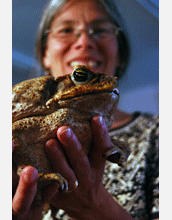Multimedia Gallery
Toad Muscle Research (Image 1)
Toad Muscle Research (Image 1)
A cane toad from Suriname is helping Northern Arizona University (NAU) Regents Professor Kiisa Nishikawa understand the speed, power and energy behind the toad's ability to capture prey with its tongue. Her studies offer insight into how muscles function more as springs than motors. [See related image Here.]
More about this Image
Scientists have long-held the theory that muscles behave largely like motors. But, Nishikawa suggests that muscle acts more like a spring. "Existing theories don't explain how muscles shorten rapidly," Nishikawa said. "Muscles can only shorten to do work; they can't do work by lengthening."
For example, the jaw muscles in toads and chameleons shorten in the lower jaw, and the opening of the jaws causes the tongue to stretch by its own momentum. A toad's jaw muscles can produce forces greater than 700 times the animal's weight. "The best electric motor achieves about one-third of that force-to-weight ratio," Nishikawa noted. "When a toad or chameleon captures prey with its tongue, it exerts force over a distance. Figuring out how they do it has immense application to any device that actually moves."
Nishikawa is working with Tom Sugar and his colleagues of Arizona State University's (ASU) Human Machine Integration Laboratory. Sugar and his team are building "SPARKy" (Spring Ankle with Regenerative Kinetics), a robotic tendon that mimics biology by storing and releasing energy during the ankle gait cycle.
"Energy is stored as the leg and body rolls over the ankle, and then this energy is released in a powerful burst to propel the user forward. By mimicking biology, we are able to build a very lightweight and functional device," Sugar said.
Findings from this research could lead to the design of more efficient electric motors, better prostheses and new medical treatments for neuromuscular diseases like Parkinson's. Nishikawa's studies of the neuromuscular basis for extremely rapid movements in animals, such as the toad snaring prey with its tongue, could leapfrog to a new model of muscle function, changing the standard representation of muscle as a motor.
Nishikawa's and Sugar's research caught the interest of Discovery Channel Canada, which spent a day at NAU and a day at ASU taping for a segment of its Daily Planet show that will air in the fall. [Research supported by National Science Foundation grant IBN 02-40349, IOS 06-23791 and IOS 07-32949.] (Date of Image: May 2008)
Credit: Danielle Borth, Northern Arizona University
Images and other media in the National Science Foundation Multimedia Gallery are available for use in print and electronic material by NSF employees, members of the media, university staff, teachers and the general public. All media in the gallery are intended for personal, educational and nonprofit/non-commercial use only.
Images credited to the National Science Foundation, a federal agency, are in the public domain. The images were created by employees of the United States Government as part of their official duties or prepared by contractors as "works for hire" for NSF. You may freely use NSF-credited images and, at your discretion, credit NSF with a "Courtesy: National Science Foundation" notation.
Additional information about general usage can be found in Conditions.
Also Available:
Download the high-resolution JPG version of the image. (2.2 MB)
Use your mouse to right-click (Mac users may need to Ctrl-click) the link above and choose the option that will save the file or target to your computer.



